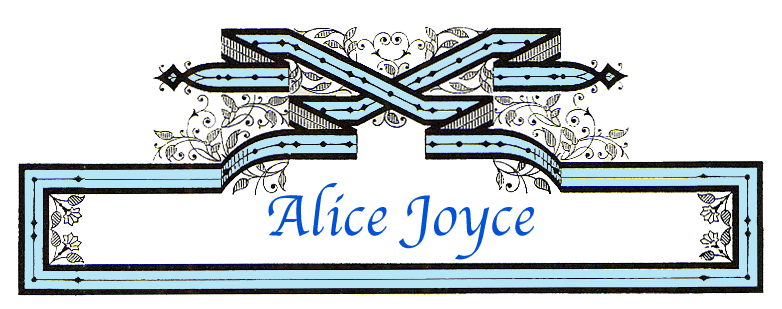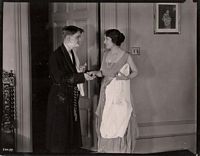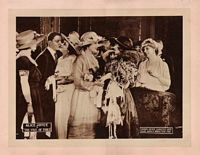

The Vice of Fools (1920) Vitagraph Co. of America. Distributor: Vitagraph Co. of America; Alice Joyce Productions. Director: Edward Griffith. Assistant director, John William Evans. Scenario: C. Graham Baker. Story: Francis James. Camera: Joe Shelderfer. Cast: Alice Joyce, Ellen Cassity, Robert Gordon, Raymond Bloomer, William Tooker, Elizabeth Garison, Agnes Everett. 5 reels This film appears to be LOST
 |
Two lobby cards and a still for the film (thanks to Derek Boothroyd for these scans) |  |
 |
 |
Two color lobby cards (including the title card), also from Derek Boothroyd |  |
Opinion divides "The Vice of Fools" pointedly between a handsome and altogether satisfactory production background and shallow, almost threadbare story.
It is hard to recognize Alice Joyce in this Vitagraph production without expressing the hope that in future pictures she will be provided with stories that have more value, more meat and depth than "The Vice of Fools." She is an actress of conspicious [sic] ability, who possesses more screen intelligence than a good number of her contemporaries.
In all it inspires the conviction that whereas directors and photographers have attained a greater degree of maturity, bringing them nearer perfection in the art, one factor still remains to be added--the story.
The theme is blindness and impetuousness of youth which overlooks the truth. There is the attractive woman. She is eventually married, though on her part out of pique. The usual emptiness prevails and the husband discovers the mendacity of his mate. Bang! His vision is restored. He finds happiness with the woman who had sacrificed a good deal for him, without his being aware of it, of course, until the title explains the motive.
Ed Griffith's direction, while showing aptitude and artfulness in being able to surround the picture with fine incidentals, fails in bringing action into the picture. At the most his single climax has small effect.
The picture suffers from a certain unconvincingness. This is cause in part by casting Ellen Cassity for the role of Diana Spalding. The part calls for a woman attractive enough to command interest in herself, so that the role handled by Alice Joyce shall not inadvertently be made less substantial than the Spaulding role. If the role had been entrusted to someone, say, of the vamp type, the picture would surely have been more convincing. The boyishness of Robert Gordon asserts itself with some degree of merit in this production. Miss Cassity does a number of her scenes quite capably, but under the circumstances should have been case for a different picture. In the support in minor bits are Elizabeth Garrison, William Tooker, Reginald Bloomer and Agnes Everett.
The play is from the story by Francis James, the scenario by C. Graham Baker, the photography by Joe. Schelderfer.
Story by Francis James. Directed by Edward Griffith. Released by Vitagraph.
| Marion Rogers | Alice Joyce |
| Diana Spaulding | Ellen Cassity |
| Cameron West | Robert Gordon |
| Granville Wingate | Raymond Bloomer |
| Capt. Cyprian Streatfield | Lionel Pape |
| Stewart Rogers | William Tooker |
| Mrs. Rogers | Elizabeth Garrison |
| Mrs. Spaulding | Agnes Everett |
[omitted, 3 photos: 1. Joyce looking anxiously at a man. Caption: Above, Alice Joyce and Robert Gordon in "The Vice of Fools" (Vitagraph) have a heart-to-heart talk. 2. Joyce in a light colored chiffon dress. Caption: At the right, Alice Joyce as the heroine of "The Vice of Fools" (Vitagraph) takes a breath of air. 3. Joyce (same dress) smiles and holds a man's collar while another woman watches. Caption: Below, Ellen Cassity enters upon a scene of domestic felicity with Alice Joyce and Robert Gordon as its principals ]
Since the world first began it has been the primeval instinct in women to sacrifice their all--if need be--on the altar of their love--or in a moment's folly in spite of this love to toss away a world of undreamed happiness. Woman is the eternal riddle of a complicated world as the wise men of the East have said and in their wisdom steer wide and clear of them.
It is just such issues--significant, everyday emotions that decide the destinies of individuals--that "The Vice of Fools" is based upon. The direction has been done with excellent care and the minuteness of detail work and careful clever editing of the titles helps to make the picture convincing.
Alice Joyce, (at all times stunning and captivating with her whimsical personality) wears some gorgeous gowns, and wears them with a very vivid distinction. She is given many fine opportunities to use her stored-up talent and she takes good advantage of these moments. She is one of the most finished artists of the screen and it is always a delight to watch her work.
The settings of the high social life have been done with remarkable technique and perfect taste. It takes very little credence to believe it is the real thing. The photography is clear and the lighting effects have been handled with skill.
Robert Gordon enacts the role of the hero and does it to the Queen's taste. He has a pleasing "screen presence" and is altogether a most likeable young fellow.
The rest of the cast admirably support the star and indeed come in for an unusual amount of praise for the part they play in making this feature one of pleasant, delightful entertainment--especially for the women.
It is more of a photoplay for the fair sex (there is an appeal to the great desire to be in the vogue). However all this may be, the picture will live long enough to bring hours of amusing pastime.
"THE VICE OF FOOLS"
Society Drama of the Popular Type Released by Vitagraph, Stars Alice Joyce
Reviewed by Mary Kelly.
A marked effort to follow popular taste rather than to introduce anything decidedly original in the way of plot or plot treatment, is evident in Vitagraph's "The Vice of Fools." The story, with an idealistic trend, showing what a great sacrifice one woman makes for another who is obviously undeserving, is the type of subject that meets generally with favor, but to some it is bound to appear as somewhat far fetched.
To promote the union of a good man with a coquette and later to keep the husband from knowing the truth about his wife's infidelity is the task which has been allotted to the heroine. This seems to indicate a mistaken idealism on the part of the author, an effort to evoke admiration from the spectator for a series of acts that really benefit no one. This irregularity in the reading of human life and character is more or less noticeable throughout the picture. For instance, the incident of the young wife's refusal to tie her husband's cravatte seems a petty if not actually crude way of indicating the growing estrangment [sic]. A little more discernment on the part of the author and director would have remedied this.
There is much that is attractive about the picture in the way of sets, cast and costumes. It represents a generous expenditure of time and money. Alice Joyce is pleasing in a congenial role. Robert Gordon's sincerity compensates, in part, for the weakness of his role and the other principals, too give satisfaction
Cast.| Marion Rogers | Alice Joyce |
| Diana Spaulding | Ellen Cassity |
| Cameron West | Robert Gordon |
| Granville Windgate | Raymond Bloomer |
| Stewart Rogers | William Tooker |
| Mrs. Rogers | Elizabeth Garrison |
| Mrs. Spaulding | Agnes Everett |
Story by Francis James.
Scenario by Graham Baker.
Edward Griffith.
Length, Five Reels.
The Story.
Marion Roger's love affair with Cameron West is broken up by her mother whose disapproval is so evident that Cameron gets discouraged. He develops an infatuation for Diana Spaulding, a flirtatious society debutante. Marian watches the progress of the affair regretfully, and then decides to forget it by accepting the attentions of Wingate, an adept in the love game.
Diana also is encouraging Wingate and is discovered flirting with him, by Cameron, who decides that the quickest way to cure her is to marry her. This he does and unhappiness follows. Wingate's manner becomes insulting toward Marion and she gives him up. One day Cameron discovers that Marion is trying to prevent him from knowing the truth about his wife and her infatuation for Wingate. His efforts to check this are fruitless.
A few evenings later at a party at the Rogers' home, Marion slips out of the house in search of a partner whose number corresponds to hers in the stunt game which they are about to engage in. She hears Diana and Wingate planning to elope, and determines to prevent this for Cameron's sake. The place set for the lovers' rendezvous is the dock. Marion hastens to meet Wingate before Diana can get to him. Through her clever interference she succeeds in dismissing Wingate, who leaves without Diana. She goes back to the house and arrives before Diana has left. A storm of words follows between the two women, who are interrupted by Cameron. Marion accounts for her absence and shields Diana from disgrace in her husband's eyes.
Cameron's love for Marion is too great for him to conceal and they agree to await the coming of happier days when fate will grant their union.Last revised December 6, 2011